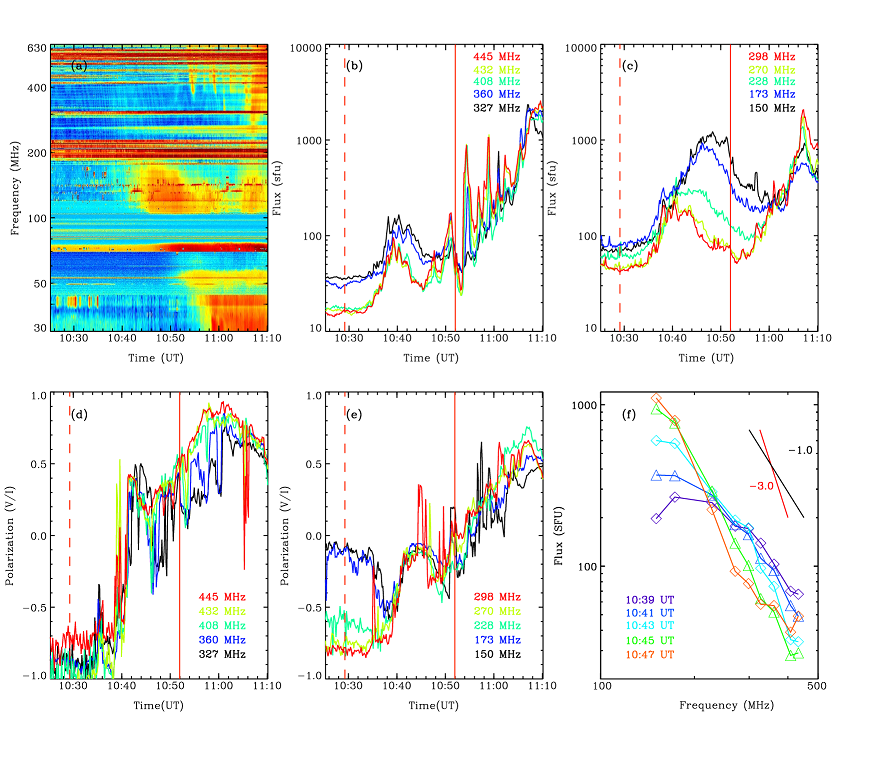An Eruptive Hot-Channel Structure Observed at Metric Wavelength as a Moving Type-IV Solar Radio Burst
V. Vasanth, Y. Chen, S. W. Feng, S. Ma, G. Du, H. Q. Song, X. L. Kong, and B. Wang
The sudden enhancements of non-thermal radio emission from the solar corona due to energetic electrons are observed as solar radio bursts. They follow the solar activities such as flares and CMEs. It is well known that there exist five types of radio bursts at the metric wavelength, including type-I, II, III, IV and V. The type-IV radio bursts are broadband continuum emission, further classified into moving and static bursts. They are believed to be excited by energetic electrons within certain magnetic structures such as magnetic arches, loops or plasmoids. Different emitting mechanisms have been proposed, including gyro-synchrotron, plasma emission and electron cyclotron maser emission.
In recent years the SDO observations show that Hot Channel (HC) structures as one candidate of coronal flux ropes that are main energy carrier of solar eruptions. The energetic electrons if existing within this HC-flux rope structure, can act as a possible source for emitting solar radio bursts. This observation of a radio HC may provide a novel diagnostic method to infer the properties of this critical structure.
Here we present the first radio imaging study of an eruptive HC structure in the metric wavelength. The associated radio emission observed on 4thMarch 2012 is manifested as a moving type-IV radio burst. The eruptive structure is shown to be an HC structure, since it appears only in the 94 and 131 Å of SDO/AIA pass bands.
Figure 1 shows the observed eruptive HC structure in 94, 131 and 171 Å during pre-eruptive, eruptive and post-eruption stages. The pre-eruptive stage (top panels) shows the slow rise of flux rope structure from the active region visible in 131 and 94 Å and not visible at 171 Å. The eruptive stage (middle panels) shows the evolved plasmoid structure connected to a co-moving faint arcade feature, it is clearly observed at 131 Å. It indicates that the structure contains high temperature plasmas. During the eruption, the HC gradually fade and becomes invisible around 10:45 UT, while at its northwestern foot there appears an obvious dimming region. The dimming is likely due to evacuation of plasmas (bottom panels).

Fig. 1 - The HC eruption recorded by AIA at 131, 94, and 171 Å at (a) 10:33 UT (to show the slowly rising HC, red arrows), (b) 10:40 UT (to show the eruptive plasmoid-HC structure, white arrows), and (c) 10:46 UT (to show the dimming foot region, green arrows). S1 is for the distance maps.
The moving type-IV (t-IVm) burst in the present study is recorded by Artemis radio spectrograph and imaged by Nancy radio heliograph (NRH). From Figure 2, we see a wide-band continuum emission from ~ 200 – 20 MHz with a trend of downward drift in time. The high frequency counterpart is not clear possibly due to low sensitivity of the Artemis instrument as well as the strong radio interference. Yet, according to the much more sensitive measurements of NRH, there exist weaker yet significant emissions from 150 – 445 MHz. Their corresponding flux, polarization and spectral index are shown in Figure2.

Fig. 2 - Characteristics of the t-IVm burst as recorded by Artemis and NRH. (a) the Artemis dynamic spectrum; (b-c) total NRH fluxes and (d-e) polarization levels; (f) the emission spectra at selected moments. The two vertical lines indicate the flare start and peak time.
We further examine the spatial correlation of the radio burst and the eruptive structure. The radio sources co-move outward with the HC structure, indicates that the t-IV emitting energetic electrons are efficiently trapped within this HC structure (see Figure 3). The t-IV sources at different frequencies present no considerable spatial dispersion during the early stage of the event (top panels), while the sources spread gradually along the eruptive HC structure at later stage with significant spatial dispersion (middle panels).Later, the sources line up from high to low frequencies (bottom panels).
These observations indicate that the t-IVm sources are emitted by energetic electrons that are first trapped within the plasmoid structure and then get scattered along the expanding side-arcade structure of the eruptive HC.

Fig. 3 - (a-c) Temporal evolution of the NRH sources, superposed onto the closest-in time AIA 131 Å images. The NRH data are represented by the 95% TBmax contours. The yellow dotted lines present the outline of the side arcade inferred at 10:40 UT.
This study demonstrates the possibility of imaging the eruptive HC structure at the metric wavelength and provides strong constraints on the type-IV emitting mechanism, which if understood, can be used to diagnose the essential parameters of the eruptive structure.
The manuscript has been accepted for publication in Astrophysical Journal Letters.
Please see the manuscript for further details.
(http://arxiv.org/pdf/1609.06546v1.pdf)
